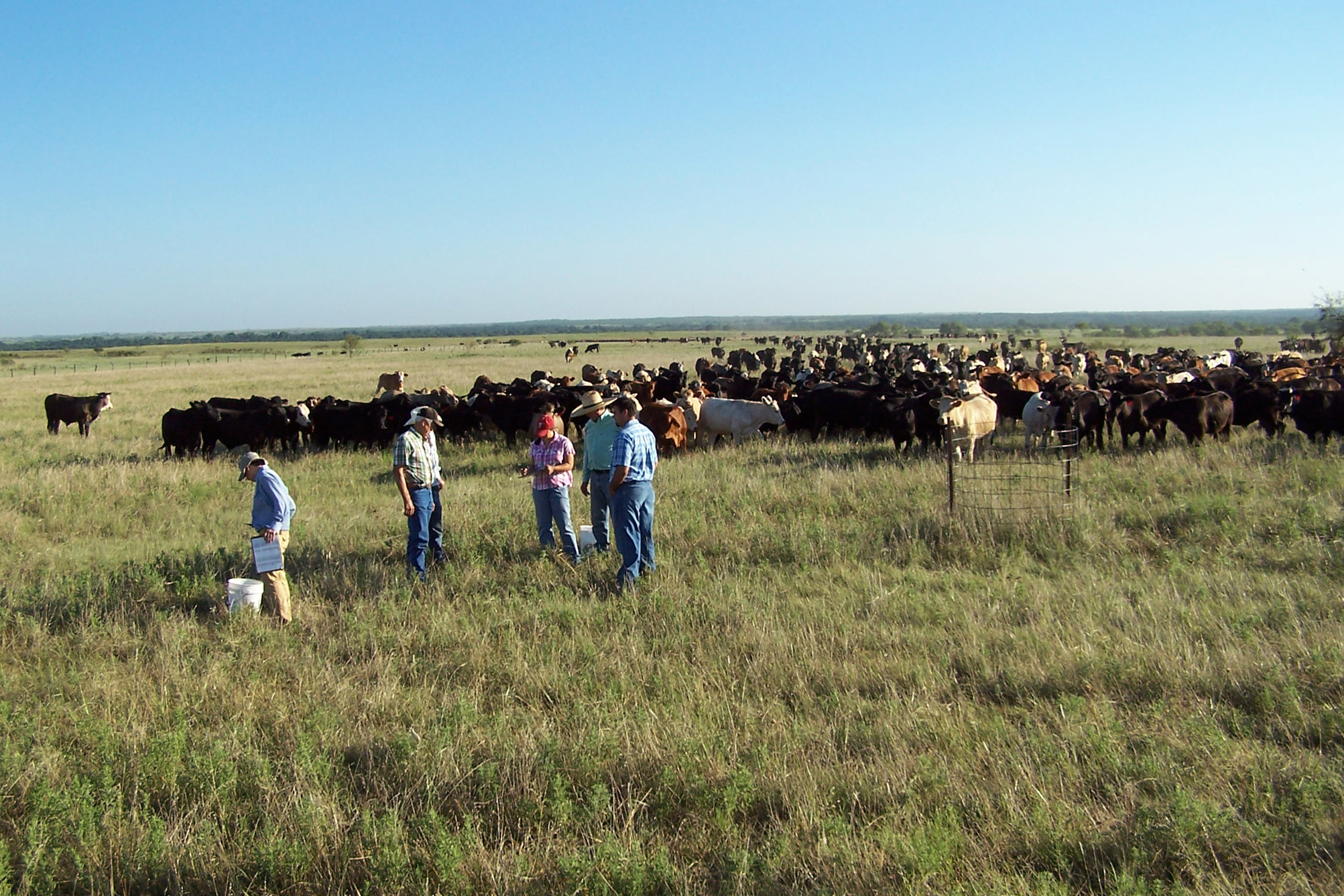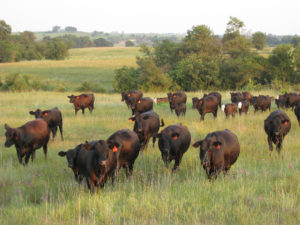Farm & Ranch
[AgriLife Today] Grazing to improve soil health, producer profits

By: Kay Ledbetter
Texas A&M AgriLife researcher leads effort to find optimum management strategies
Writer: Kay Ledbetter, 806-677-5608, [email protected]
Contact: Dr. Richard Teague, 940-552-9941, [email protected]
VERNON – Dr. Richard Teague might be considered a cowboy of a different kind. He’s not rounding up stray cattle, but rather wrangling the best management practices on ranches to help the cattle and their owners.

A North Texas ranch managed with moderate densities of animals that are being moved to a new paddock. The amount of grass left will allow for quick recovery. (Texas A&M AgriLife photo by Dr. Wayne Becker)
Teague, a Texas A&M AgriLife Research ecologist at Vernon, grew up on a farm and knows firsthand there are some unintended consequences from traditional long-standing agricultural practices that might not readily be seen.
“I’m an ecologist and know that for an adequately functioning ecosystem, you have to have good soil function,” Teague said. “Many things we do in industrial agriculture break down the function of soil. The ranchers and farmers we are working with have demonstrated how to increase productivity by improving soil health, manage for decreased inputs, improve the health of their cattle and increase profits.”
Teague’s long-term research, which began in North Texas, is getting noticed. He recently was asked to join the leadership of a research group that includes 26 researchers from 18 universities and private entities.
On this project, Teague will be in charge of the grazing management project design and oversight. He is joined on the project by fellow AgriLife Research scientist Dr. Urs Kreuter in Texas A&M University’s department of ecosystem science and management, College Station.The project is titled “Can Adaptive Multi-Paddock (AMP) grazing contribute to sequestering carbon in soils and improve delivery of ecosystem services and socio-ecological resilience in grazing ecosystems?”
Teague said this study will help bridge a big gap in the science between management effects on a ranch scale and results from small-plot research.
The group started with a $500,000 grant from Shell Alberta in 2016 to do reconnaissance sampling to provide proof of concept that AMP grazing management improves ecological, water catchment and economic value, as his research showed in Texas.
“We were successful in getting some smaller grants to do preliminary sampling to make sure the principles held true in cooler areas to the north, wetter areas to the east and drier areas in the west,” he said. “With these results and data, we started putting together grants to expand this work.”
McDonald’s Corp. kicked off the effort with a $4.5 million grant and is facilitating obtaining additional funding, Teague said. Now more entities are indicating a willingness to put money into this research effort.
“The reason they support the research is because they want to help address the food and health concerns of consumers,” he said. “Agriculture has a role to play in finding solutions to our health problems. Many groups are realizing that in the future they are going to have to show their food comes from healthy sources and ones that do not damage the environment.”
The Canadian government has also funded a similar grant in Alberta, Saskatchewan and Manitoba for $2.6 million, of which Teague and members of the U.S. team are a part. The aim is to determine how much soil carbon can be increased by using AMP grazing relative to continuous grazing on neighbor farms.
Restoring soil health and economic stability for farmers are at the base of Teague’s group’s research. Their big questions are whether it improves soil health and the livelihood of the farmer.
The International Year of Soils was celebrated in 2015 by the United Nations Food and Agriculture Organization’s Global Soil Partnership. A Global Soil Security Symposium brought scientists, policy influencers, investors and citizens together at Texas A&M University in College Station to start the process of developing an international soil security policy.
A worldwide Global Soil Security Symposium was held in 2016 in Paris. A second meeting was held in Paris in May 2017, and Teague was invited to present the team’s research there.
The focus of these efforts was to recognize the importance of soil science in the current global challenges of human health, food and water security, the role of soil carbon to improve ecosystem functions and biodiversity under a changing climate.
Teague said his team of collaborators around the country started their project by outlining some of the damage to soil and soil losses being seen in agriculture and then determining possible solutions.
They began their search for solutions by identifying producers across the U.S. and Canada who have won conservation awards by improving soil and ecosystem health. They analyzed these individual operations to capture what was done on the land, how it was done and what desirable results were achieved.
“It’s important to incorporate leading farmers such as these because you have to show what you are saying actually cash flows on a working operation and has potential to get people into a much better economic position,” Teague said.
In Canada, the team is assessing what different grazing management has done to soil health. At the root of all the proof of concept operations is AMP grazing, which has been found to be an effective restoration practice on grazing lands for enhancing water conservation and protecting water quality, Teague said.
“We have already taken detailed measurements of current additions of carbon on ranches in Canada that have been managed using AMP grazing for 20 years at the same time as measuring across the fence on neighboring ranches that have been managed using the usual continuous grazing management.”
Teague said in grazing and cropping systems, the damage to the structure of the soil universally impedes the penetration and the soil’s water-holding capacity. Only healthy soil can provide those two functions adequately.
“Not only does AMP grazing provide several hydrological benefits such as increased soil infiltration, increased water conservation and decreased surface runoff and erosion, but also environmental benefits such as water quality improvement,” he said.
Teague said soil organisms are responsible for more than 90 percent of how the soil-plant system and ecosystem function. The amount of carbon in the soil, identified by organic matter, greatly influences the abundance of microbial life, and soil-water holding capacity is increased in direct proportion to the amount of organic matter in the soil.
Fungi are particularly important as they provide soil nutrients and water that plants cannot access without their help, Teague explained.
“Most current grazing management results in decreased soil microbial composition and function,” he said. “But improved management has been shown to reverse the causal mechanisms of degradation by promoting the physiological factors that favor a healthy ecosystem and restoring the dominance of the most productive plant species.”
When conducting research of this nature, Teague said it is important to remember “changes come slowly and you have to manage it for enough years that you have a measurable difference.”
-30-
Find more stories, photos, videos and audio at http://today.agrilife.org
Farm & Ranch
Meanwhile, Back at the Ranch…

By Rayford Pullen | [email protected]
When May arrives, we start thinking about weed control. With two years of drought under our belts, grass grazed short and hay stocks depleted, what we do now will influence our forage conditions for the entire year. With 75 percent of our annual warm season forages made by July 15 in North Texas, we need to get the grass growing while the sun shines.
Speaking of the sun shining, the biggest deterrent to growing lots of grass is restricted sunlight, and the biggest sun blockers we have are weeds.
Have you noticed weeds are normally just slightly taller than your grass and are probably blocking 90 percent of the sunlight from reaching the grass itself? So obviously, we need to improve conditions, so sunlight reaches the plants we want to grow.
With grass extremely short, more sunlight is hitting the soil surface now, which in turn results in more weed seed germinating. With the moisture we have received, we expect an abundance of weeds this year.
To read more, pick up a copy of the May issue of NTFR magazine. To subscribe by mail, call 940-872-5922.
Farm & Ranch
Land Market Report: March Land Sales

By Jared Groce
Rural land sales are continuing on a steady pace for early spring, with prices holding very strong with the sell-to-list price ratios remaining very high, even on properties that have been on the market for a longer than usual time period. The total number of transactions are picking up once again as the spring selling season kicks off, and the average acreage continues to decrease.
Larger acreage properties seem to be in higher demand than smaller properties currently, with many buyers simply parking cash in real estate to hedge against inflation. Interest rates seem to have settled down and most experts agree that rates will be reduced by the fed this year. Some lenders have programs in place that allow the buyer to reduce their rates without having to go through a full refinance ordeal.
To read more, pick up a copy of the May issue of NTFR magazine. To subscribe by mail, call 940-872-5922.
Farm & Ranch
Texas FFA State Vice President Weston Parr

Future Farmers of America was founded by a group of farmers in 1928 with the mission of preparing the next generation of agriculture. It has done just that during its 95-year history, as the organization works to give back to others by following its motto, “learning to do, doing to learn, earning to live, living to serve.”
FFA is an organization made up of state associations, and at the helm of the Texas FFA is a team of 12 officers representing their respective areas within the Lone Star State. These individuals dedicate a year of their lives as they serve members, provide leadership, and work together with the state staff and board of directors to develop policy and lead the organization of over 177,000 members.
North Texas is represented by Area IV and Area IV, stretching from Wilbarger County to Bell County and from Runnels County to Grayson County. This year, those chosen to lead this great area are State President Isaac Hawkins Jr., Area IV, and State Vice President Weston Parr, Area V.
Parr is from the Sam Rayburn FFA chapter and the Area V Association, but the leader who now serves more than 19,100 members of Area V entered the FFA organization as a shy teenager who sat in the back of the room.
“I didn’t talk to a whole lot of people. I didn’t know what I wanted to do with my life or where I could see myself, so I wasn’t involved on my high school campus,” Parr recalled.
“Then I started FFA and slowly but surely, my ag teachers worked me into attending more contests, meeting new people, and speaking. I remember the first time I gave an officer speech to my chapter. I can still remember how embarrassing it was. To see the progression from that moment to speaking on stage at the state convention in front of thousands of people. Now I feel like I can enter the industry I want and be successful all because of what FFA afforded me for five years.”
There is not much Parr did not do during his time in high school. His contest participation included chapter conducting, wool judging, cotton judging, wildlife, and job interview, but his favorite was extemporaneous speaking, which he did not start until his senior year of high school.
“I wish I could go back to my freshman, sophomore, and junior years and start that sooner. I think if I had more time, I would have been more successful than I already was, but that was something I didn’t realize I liked at the time. I’m not naturally somebody who likes to speak in public, but it was actually my favorite,” Parr said.
Parr won several awards during his time competing. In 2023 alone, Parr earned the Texas FFA Service-Learning Proficiency title, was a National FFA Service-Learning Proficiency finalist, and a Texas FFA Extemporaneous Speaking finalist. In addition to his CDE and LDE events during high school, he showed commercial steers at Houston, and boilers at most major shows, participated in the county show with projects in ag mechanics, showed goats from time to time, and showed heifers until graduation.
“FFA provides invaluable resources and knowledge to be successful once you leave high school and you are out of the blue jacket for the first time. I have been a part of a lot of great organizations over the years, and they are all great in their own way, but in my opinion, FFA is the most successful at producing members of society who want to go and do something with themselves,” Parr said.
He was halfway through his time as Area V Association President and attending the national convention when he began to ponder the idea of running for state office.
“This is around the time when you usually figure out if you want to go through and be a state officer or you decide that area officer is your last run. I was unsure of where I wanted to go, but I knew I didn’t want to be done with FFA. I decided maybe it would be a good opportunity not only for me to make more friendships and connections, but also to give back to the program that allowed me to be able to do what I can do today,” Parr explained.
To read more, pick up a copy of the May issue of NTFR magazine. To subscribe by mail, call 940-872-5922.
-

 Country Lifestyles1 year ago
Country Lifestyles1 year agoScott & Stacey Schumacher: A Growth Mindset
-

 Equine8 months ago
Equine8 months agoThe Will to Win
-

 Country Lifestyles7 years ago
Country Lifestyles7 years agoStyle Your Profile – What your style cowboy hat says about you and new trends in 2017
-

 Country Lifestyles4 years ago
Country Lifestyles4 years agoAmber Crawford, Breakaway Roper
-

 HOME7 years ago
HOME7 years agoGrazing North Texas – Wilman Lovegrass
-

 Country Lifestyles7 years ago
Country Lifestyles7 years agoDecember 2016 Profile, Rusty Riddle – The Riddle Way
-

 Outdoor9 years ago
Outdoor9 years agoButtercup or Primrose?
-

 Country Lifestyles8 years ago
Country Lifestyles8 years agoJune 2016 Profile – The man behind the mic: Bob Tallman






